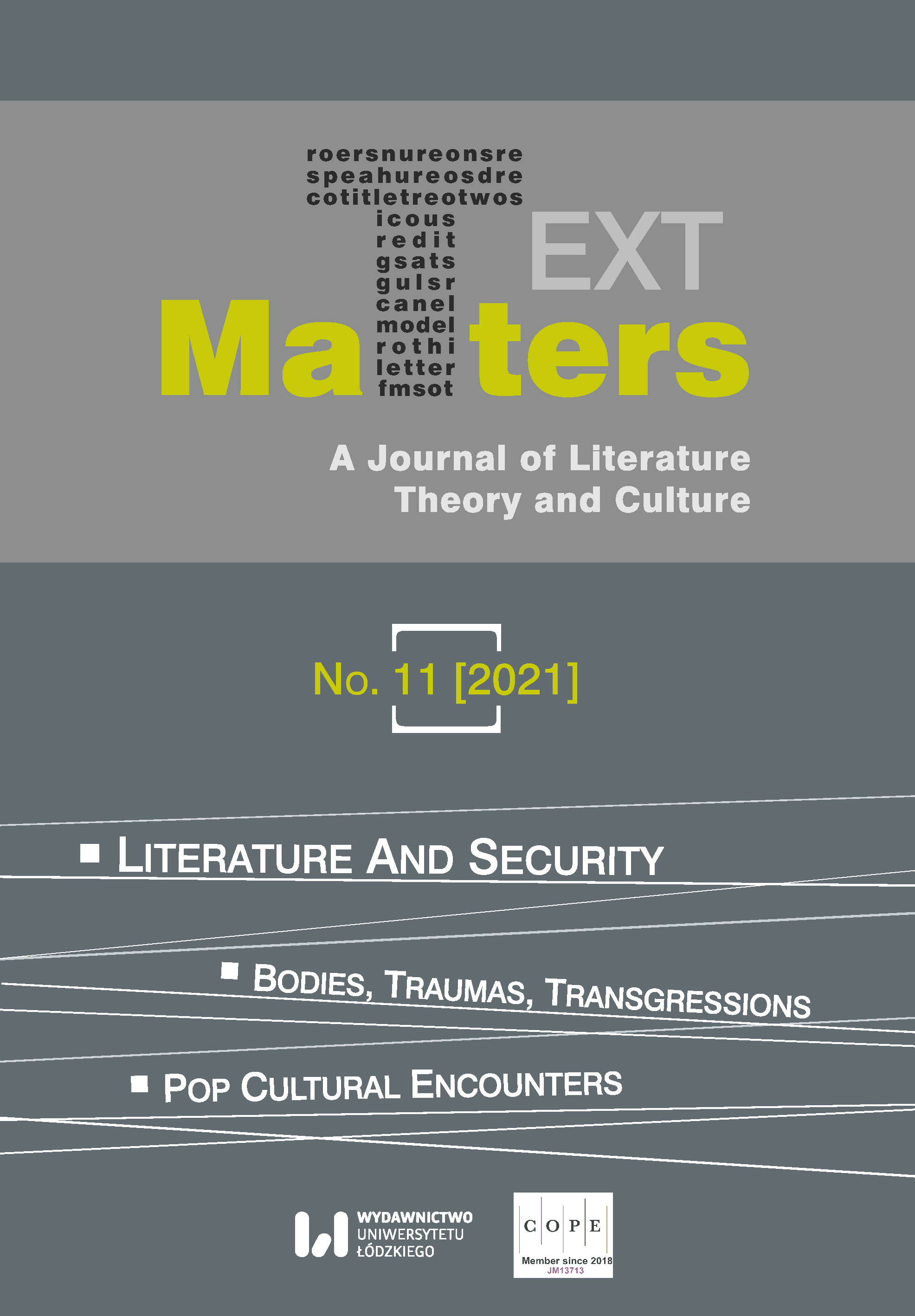Performing More-Than-Human Corporeal Connections in Kiki Smith’s Sculpture
DOI:
https://doi.org/10.18778/2083-2931.11.15Keywords:
performative arts, more-than-human entanglements, American art, Kiki Smith, Joseph BeuysAbstract
The article examines work by contemporary American artist Kiki Smith, who proposes a future in which human and nonhuman bodily borders merge. The artist’s contribution to the more-than-human artistic entanglements is juxtaposed with Joseph Beuys’s artistic manifesto from 1974 which proposes, among other things, an attempt to get outside of the represented human towards the asignified ahuman. In Kiki’s sculpture, both human and nonhuman animals undergo constant morphogenesis, becoming hybrid forms far beyond the human-social paradigm, implying that the human and nonhuman binary, due to the exchange of affective entanglements, is no longer valid in the heyday of techno-scientific development. The analyzed work shows that both human and nonhuman bodies are raw materials not separated from one another but always interconnected with the world and its ongoing material processes. Thus, the article emphasizes that it is only through the transgression of the human and nonhuman border that one can acknowledge the more ethical and political ways of cooperation needed for the appreciation of the multispecies dimension of our world and its survival.
Downloads
References
Adams, Carol J., and Lori Gruen, editors. Ecofeminism: Feminist Intersections with Other Animals and the Earth. Bloomsbury, 2014.
Google Scholar
DOI: https://doi.org/10.5040/9781501388323.0007
Barad, Karen. Meeting the Universe Halfway. Quantum Physics and the Entanglement of Matter and Meaning. Duke UP, 2007. https://doi.org/10.1515/9780822388128
Google Scholar
DOI: https://doi.org/10.2307/j.ctv12101zq
Bennett, Jane. Vibrant Matter: A Political Ecology of Things. Duke UP, 2010. https://doi.org/10.1515/9780822391623
Google Scholar
DOI: https://doi.org/10.2307/j.ctv111jh6w
Braidotti, Rosi. “Feminist Philosophies.” A Concise Companion to Feminist Theory, edited by Mary Eagleton, Blackwell, 2003, pp. 195–214. https://doi.org/10.1111/b.9780631224037.2003.00012.x
Google Scholar
DOI: https://doi.org/10.1111/b.9780631224037.2003.00012.x
Braidotti, Rosi. Nomadic Theory: The Portable Rosi Braidotti. Columbia UP, 2011.
Google Scholar
Broglio, Ron. Surface Encounters: Thinking with Animals and Art. U of Minnesota P, 2011.
Google Scholar
DOI: https://doi.org/10.5749/minnesota/9780816672967.001.0001
Deleuze, Gilles, and Felix Guattari. A Thousand Plateaus. Capitalism and Schizophrenia. Translated by Brian Massumi. U of Minnesota P, 1987.
Google Scholar
Deleuze, Gilles, and Felix Guattari. Kafka: Toward a Minor Literature. Translated by Dana Polan. U of Minnesota P, 1986.
Google Scholar
De Miranda, Luis. “Is a New Life Possible? Deleuze and the Lines.” Deleuze Studies, vol. 7, no. 1, 2013, pp. 106–52. https://doi.org/10.3366/dls.2013.0096
Google Scholar
DOI: https://doi.org/10.3366/dls.2013.0096
Despret, Vinciane. “The Body We Care for: Figures of Anthropo-zoo-genesis.” Body & Society SAGE Publications, vol. 10, no. 2–3, 2004, pp. 111–34. https://doi.org/10.1177/1357034X04042938
Google Scholar
DOI: https://doi.org/10.1177/1357034X04042938
Haraway, Donna J. Staying with the Trouble. Making Kin in Chthulucene. Duke UP, 2016. https://doi.org/10.1515/9780822373780
Google Scholar
DOI: https://doi.org/10.1215/9780822373780
Haraway, Donna J. “Training in the Contact Zone: Power, Play, and Invention in the Sport of Agility.” Tactical Biopolitics: Art, Activism, and Technoscience, edited by Beatriz da Costa and Kavita Philip, The MIT P, 2008, pp. 445–65. https://doi.org/10.7551/mitpress/9780262042499.003.0026
Google Scholar
DOI: https://doi.org/10.7551/mitpress/9780262042499.003.0026
Haraway, Donna J. When Species Meet. U of Minnesota P, 2007.
Google Scholar
Jones, Amelia. Body Art. Performing the Subject. U of Minnesota P, 1998.
Google Scholar
MacCormack, Patricia. “Art, Nature, Ethics: Nonhuman Queerings.” Somatechnics, vol. 5, no. 2, 2015, pp. 120–34. https://doi.org/10.3366/soma.2015.0157
Google Scholar
DOI: https://doi.org/10.3366/soma.2015.0157
MacCormack, Patricia, and Colin Gardner. Deleuze and the Animal. Edinburgh UP, 2017.
Google Scholar
Massumi, Brian. What Animals Teach Us About Politics. Duke UP, 2014. https://doi.org/10.1515/9780822376057
Google Scholar
DOI: https://doi.org/10.1515/9780822376057
Merleau-Ponty, Maurice. “The Intertwining—The Chiasm.” The Visible and the Invisible, translated by Alphonso Lingis, Northwestern UP, 1968, pp. 130–55.
Google Scholar
Smith, Kiki. Rapture. 2001, Pace Gallery, New York.
Google Scholar
Stachelhaus, Heiner. Joseph Beuys. Abbeville, 1987.
Google Scholar
Tisdall, Caroline. Joseph Beuys. Thames and Hudson, 1979.
Google Scholar
Warner, Marina. “Metamorphoses of the Monstrous.” Fairy Tales, Monsters, and the Genetic Imagination, edited by Mark W. Scala, First Centre for the Visual Arts Vanderbilt UP, 2012, pp. 24–37.
Google Scholar
Warner, Marina. “Wolf-girl, Soul-bird: The Mortal Art of Kiki Smith.” Kiki Smith: A Gathering, 1980–2005, edited by Siri Engberg, Walker Art Centre, 2005, pp. 42–54.
Google Scholar
Wolfe, Cary. Before the Law: Humans and Other Animals in a Biopolitical Frame. U of Chicago P, 2013. https://doi.org/10.7208/chicago/9780226922423.001.0001
Google Scholar
DOI: https://doi.org/10.7208/chicago/9780226922423.001.0001
Zipes, Jack. “Fairy-tale Collisions.” Fairy Tales, Monsters, and the Genetic Imagination, edited by Mark W. Scala, First Centre for the Visual Arts Vanderbilt UP, 2012, pp. 13–24.
Google Scholar
Published
How to Cite
Issue
Section
License

This work is licensed under a Creative Commons Attribution-NonCommercial-NoDerivatives 4.0 International License.













